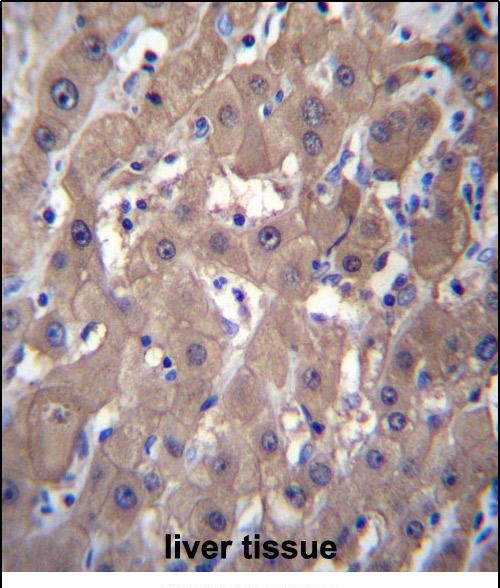AKR1C2 Antibody (C-term)
Affinity Purified Rabbit Polyclonal Antibody (Pab)
- 产品详情
- 文献引用 : 2
- 实验流程
- 背景知识
Application
| WB, IHC-P, E |
|---|---|
| Primary Accession | P52895 |
| Other Accession | Q95JH7, Q04828, NP_995317.1 |
| Reactivity | Human |
| Predicted | Monkey |
| Host | Rabbit |
| Clonality | Polyclonal |
| Isotype | Rabbit IgG |
| Calculated MW | 36735 Da |
| Antigen Region | 296-323 aa |
| Gene ID | 1646 |
|---|---|
| Other Names | Aldo-keto reductase family 1 member C2, 1---, 3-alpha-HSD3, Chlordecone reductase homolog HAKRD, Dihydrodiol dehydrogenase 2, DD-2, DD2, Dihydrodiol dehydrogenase/bile acid-binding protein, DD/BABP, Trans-1, 2-dihydrobenzene-1, 2-diol dehydrogenase, Type III 3-alpha-hydroxysteroid dehydrogenase, AKR1C2, DDH2 |
| Target/Specificity | This AKR1C2 antibody is generated from rabbits immunized with a KLH conjugated synthetic peptide between 296-323 amino acids from the C-terminal region of human AKR1C2. |
| Dilution | WB~~1:1000 IHC-P~~1:100~500 E~~Use at an assay dependent concentration. |
| Format | Purified polyclonal antibody supplied in PBS with 0.09% (W/V) sodium azide. This antibody is purified through a protein A column, followed by peptide affinity purification. |
| Storage | Maintain refrigerated at 2-8°C for up to 2 weeks. For long term storage store at -20°C in small aliquots to prevent freeze-thaw cycles. |
| Precautions | AKR1C2 Antibody (C-term) is for research use only and not for use in diagnostic or therapeutic procedures. |
| Name | AKR1C2 |
|---|---|
| Synonyms | DDH2 |
| Function | Cytosolic aldo-keto reductase that catalyzes the NADH and NADPH-dependent reduction of ketosteroids to hydroxysteroids (PubMed:19218247). Most probably acts as a reductase in vivo since the oxidase activity measured in vitro is inhibited by physiological concentrations of NADPH (PubMed:14672942). Displays a broad positional specificity acting on positions 3, 17 and 20 of steroids and regulates the metabolism of hormones like estrogens and androgens (PubMed:10998348). Works in concert with the 5-alpha/5-beta-steroid reductases to convert steroid hormones into the 3-alpha/5-alpha and 3- alpha/5-beta-tetrahydrosteroids. Catalyzes the inactivation of the most potent androgen 5-alpha-dihydrotestosterone (5-alpha-DHT) to 5-alpha- androstane-3-alpha,17-beta-diol (3-alpha-diol) (PubMed:15929998, PubMed:17034817, PubMed:17442338, PubMed:8573067). Also specifically able to produce 17beta-hydroxy-5alpha-androstan-3-one/5alphaDHT (PubMed:10998348). May also reduce conjugated steroids such as 5alpha- dihydrotestosterone sulfate (PubMed:19218247). Displays affinity for bile acids (PubMed:8486699). |
| Cellular Location | Cytoplasm, cytosol. |
| Tissue Location | Expressed in fetal testes. Expressed in fetal and adult adrenal glands. |
For Research Use Only. Not For Use In Diagnostic Procedures.

Provided below are standard protocols that you may find useful for product applications.
BACKGROUND
This gene encodes a member of the aldo/keto reductase superfamily, which consists of more than 40 known enzymes and proteins. These enzymes catalyze the conversion of aldehydes and ketones to their corresponding alcohols using NADH and/or NADPH as cofactors. The enzymes display overlapping but distinct substrate specificity. This enzyme binds bile acid with high affinity, and shows minimal 3-alpha-hydroxysteroid dehydrogenase activity. This gene shares high sequence identity with three other gene members and is clustered with those three genes at chromosome 10p15-p14.
REFERENCES
Setlur, S.R., et al. Cancer Epidemiol. Biomarkers Prev. 19(1):229-239(2010)
Wang, X., et al. PLoS ONE 5 (8), E11934 (2010) :
Reding, K.W., et al. Am. J. Epidemiol. 170(10):1241-1249(2009)
Cogliati, C., et al. FEBS J. 276(20):6011-6023(2009)
Davies, N.J., et al. Cancer Res. 69(11):4769-4775(2009)
终于等到您。ABCEPTA(百远生物)抗体产品。
点击下方“我要评价 ”按钮提交您的反馈信息,您的反馈和评价是我们最宝贵的财富之一,
我们将在1-3个工作日内处理您的反馈信息。
如有疑问,联系:0512-88856768 tech-china@abcepta.com.






















 癌症的基本特征包括细胞增殖、血管生成、迁移、凋亡逃避机制和细胞永生等。找到癌症发生过程中这些通路的关键标记物和对应的抗体用于检测至关重要。
癌症的基本特征包括细胞增殖、血管生成、迁移、凋亡逃避机制和细胞永生等。找到癌症发生过程中这些通路的关键标记物和对应的抗体用于检测至关重要。 为您推荐一个泛素化位点预测神器——泛素化分析工具,可以为您的蛋白的泛素化位点作出预测和评分。
为您推荐一个泛素化位点预测神器——泛素化分析工具,可以为您的蛋白的泛素化位点作出预测和评分。 细胞自噬受体图形绘图工具为你的蛋白的细胞受体结合位点作出预测和评分,识别结合到自噬通路中的蛋白是非常重要的,便于让我们理解自噬在正常生理、病理过程中的作用,如发育、细胞分化、神经退化性疾病、压力条件下、感染和癌症。
细胞自噬受体图形绘图工具为你的蛋白的细胞受体结合位点作出预测和评分,识别结合到自噬通路中的蛋白是非常重要的,便于让我们理解自噬在正常生理、病理过程中的作用,如发育、细胞分化、神经退化性疾病、压力条件下、感染和癌症。







